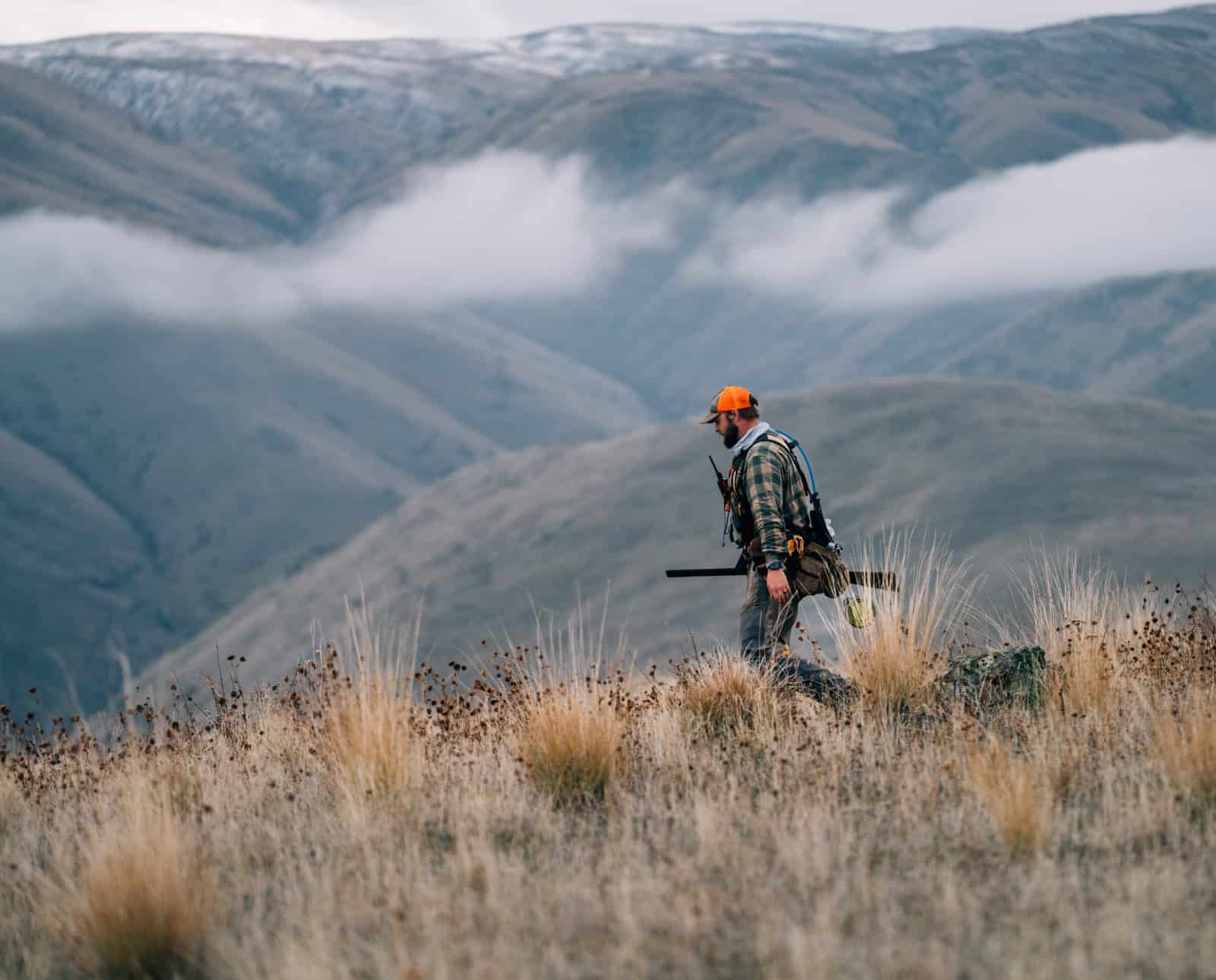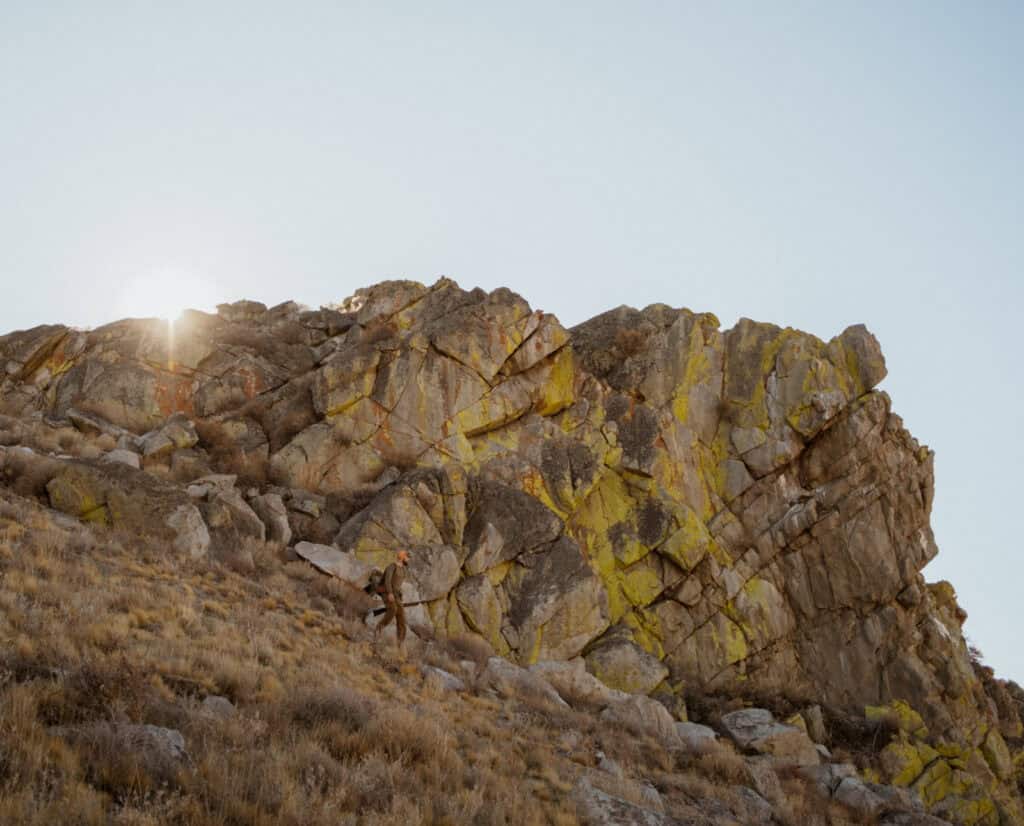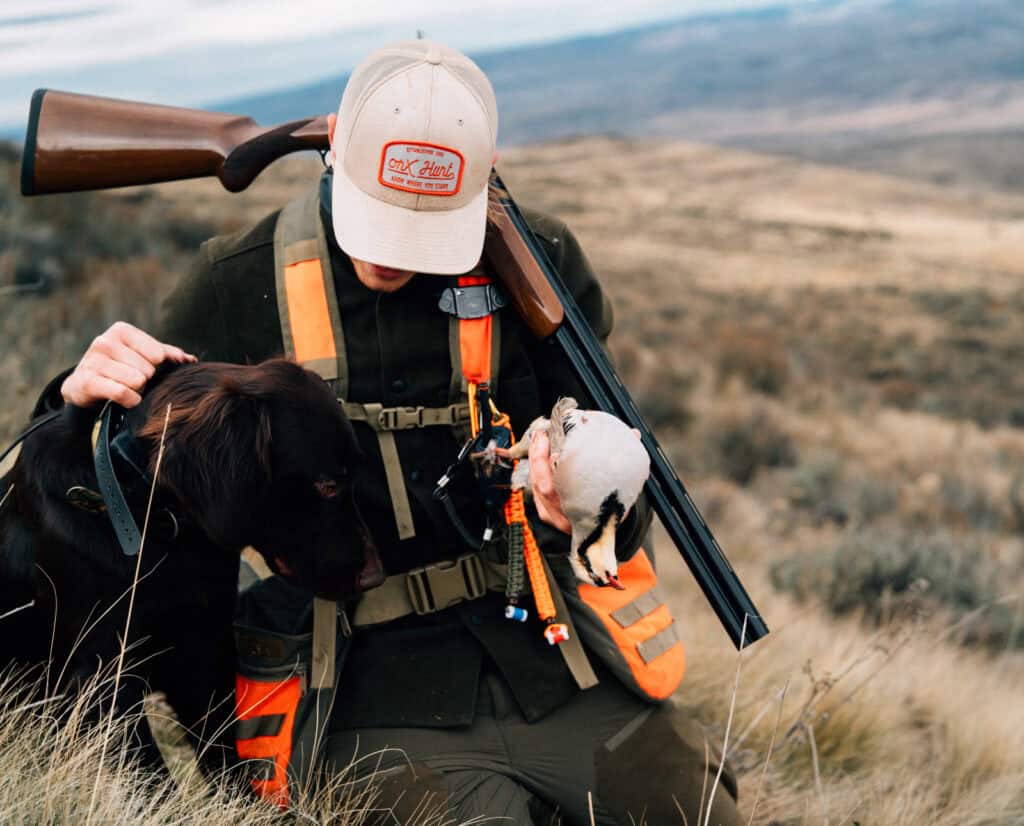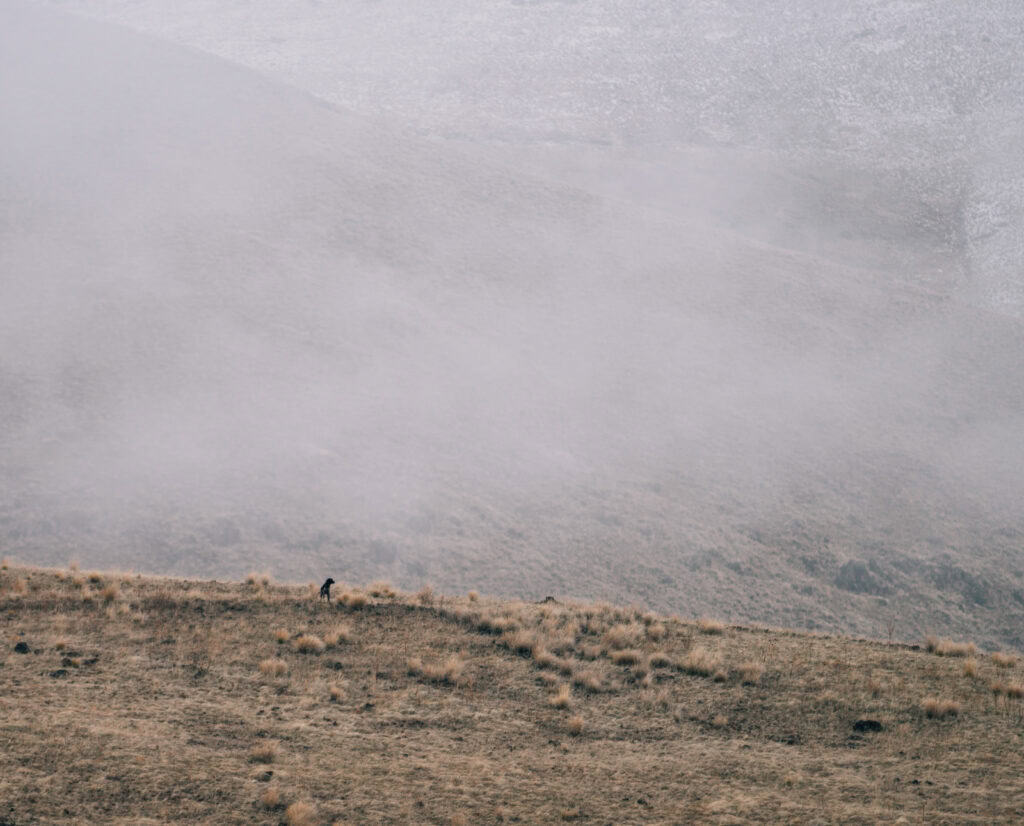Home » Partridge Species » Chukar Hunting » Complete Guide to Chukar Hunting
Complete Guide to Chukar Hunting

Jennifer Wapenski is the Director of Operations and Managing Partner…
If you enjoy hiking, scenic mountain views, and bird hunting, give public land chukar hunting a try.
Perhaps no upland game bird embodies the ruggedness of western hunting better than the chukar. They inhabit the wild, mountainous terrain that defines the vast wilderness of the Great Basin, the high desert, and the inland northwest—places where water is scarce and survival depends on adaptation to the harsh environment. Because of the physical challenges associated with reaching chukar habitat, a certain element of machismo and bro-culture has come to define the subculture of chukar hunting. It’s basically the CrossFit of the upland world.
Listen to more articles on Apple | Google | Spotify | Audible
Chukar hunting isn’t an easy stroll through a cut wheat field, but neither is it some sort of death-defying ascent limited to the youngest and fittest among us. A little bit of off-season hill training, a willingness to sweat a bit to reach the top of the next ridge, and plenty of water-carrying capacity are all you need to pursue these wild birds in their wild habitat. The extra effort required to reach them is rewarded with incredible views and a true sense of accomplishment when you do find them, even without a whack-n-stack tailgate photo.

Where To Find Chukar
The best part of chukar hunting is that the terrain they inhabit is very frequently public land and often huge sections at that. Chukar habitat is not highly sought after for agricultural purposes, which means it is undeveloped and available for public land DIY hunters.
Like any other bird, chukar require food, water, and shelter. Access to water is often the most limiting factor and will make the difference between a place that “looks birdy” but holds no birds versus a spot that reliably holds a covey. Pay attention to the location of seeps and springs, which may only be noticeable because of the presence of larger shrubs and vegetation that stand out from the arid surroundings. Guzzlers, or man-made water catchment systems, will also attract and concentrate birds in a desert environment.
Chukar are associated with the nonnative spread of cheatgrass throughout the west. They especially like eating green-up, or the tender green shoots of young grasses that appear on warm hillsides after a rain or snowmelt. Feeding generally occurs in grassier areas such as ridgetops or sun-drenched hillsides and not in the steep drop-offs where the covey is likely to seek shelter.
Shelter comes from outcroppings of rimrock, which provide camouflage and structural protection from predators. Rimrock also provides an easy escape route when the covey needs to take quick flight. You can check outcroppings for signs of chukar roosts by looking under overhangs for piles of droppings.
The presence of the survival trifecta—food, water, and shelter—is a pretty reliable indicator of good chukar habitat. With all needs met in a given location, a covey is unlikely to move very far. On the other hand, they will absolutely follow water and food up and down the mountains over the course of the year as conditions change.

Gear Required For Chukar Hunting
Gearing up for a chukar hunt should look more like preparing for a mountain hike than a typical upland hunt. The main areas of attention should be your clothing, footwear, and water capacity.
Temperatures vary wildly throughout the chukar hunting season, and mountain climates mean that weather can change very quickly. As such, a wise chukar hunter will carry plenty of layers and be ready to switch them throughout the day. Climbing up the hills will generate heat and sweat, so a lightweight, breathable base layer is a must. This is usually followed by a cold wind at the top of the ridge. To avoid getting chilled, plan to have a wind- and water-resistant outer layer ready to deploy as soon as the sweating stops. Gaiters are a great way to keep your feet and ankles dry from snow while allowing you to wear a lighter, quick-drying hiking pant. A pair of gloves will also be appreciated when that sharp wind hits.
Traversing steep, rocky terrain requires quality footwear to keep you safe and comfortable. You can plan on some degree of side-hilling, so a boot with good ankle support will help keep you upright and save your ankles for another day of hunting. Opinions and preferences are all over the map regarding hunting boot styles and brands—and no two people have identical foot shape and structure—but this is an area worth investing some time and money to find what works best for you.
Water for both you and your dog is a nonnegotiable requirement when packing for a chukar hunt. That same steep, dry, rugged terrain that you’re traversing is also being worked by your dog, often at a rate of 3-4 (or more!) times the distance that you walk. You cannot count on finding a viable water source to rehydrate and replenish your supply in chukar territory, so plan on carrying plenty of water for both of you. Also, plan on having the self-discipline to turn back when your water supply is running low to avoid tragedy.
Finally, a good vest or pack will be required to securely carry your shells, your extra clothing layers, your water, and hopefully, your birds. Choose a vest that offers plenty of flexibility to meet the needs of chukar hunting throughout the season, whether that’s tons of water in the warm, early season or plenty of outer layers to protect from the snow and rain in the wintry late season.
Shotguns, Chokes, And Shot Size Recommendations For Chukar Hunting
The best gun for chukar hunting is one that you shoot well. There’s nothing more frustrating than dragging yourself up a hillside only to miss the birds because you didn’t practice shooting in the offseason or because your gun doesn’t fit you. Whether you prefer a semi-automatic, a double-barrel, or a pump gun is entirely up to you. Weight can be a consideration if you’re looking to shed ounces for an easier climb. The availability of a third shot may be a consideration when choosing a gun; it’s not uncommon for coveys to rise in waves, leaving a final shot opportunity that inevitably presents itself after you’ve emptied both barrels at the fleeing covey.
Typical shot distances depend a lot on how pressured the birds are feeling, how secure the cover is, and how many times those birds have encountered hunters before. Early season birds located by an experienced pointing dog may provide a close shot of 20 yards, but late season birds caught in bare cover are likely to run and flush at frustrating distances. Plan for a shot and choke combination to allow you a reasonable chance of hitting a moving target at 30-40 yards. For me, that’s bismuth shot in size 6 or 7 through a modified or IC choke. But again, with the effort it takes to reach these birds, it’s worth investing a few hours in patterning your gun and figuring out which combination gives the results you like at a distance you are comfortable shooting.

Chukar Hunting Strategies
One of my least favorite pieces of hunting advice is that “the birds are where you find them.” But this is an important point to remember when encountering a covey. Look around and take note of their food source, likely shelter options, and distance to water. Those same features should be present in other areas where you search for birds; otherwise, you’ll likely waste your time in that spot.
A good dog with experience on chukar will create opportunities for you that you otherwise would never have on chukar. Of course, the only way to get this experience is to keep pursuing them and learning as you go. Range is not terribly important—my closest-ranging dog finds far more birds than my younger, bigger-running dogs because she has the learned experience to know exactly where to look and how to work the birds effectively. A dog running at 1,000 yards may look impressive, but unless they can reliably hold running birds while you drag yourself over scree and talus to get there, it’s nothing more than a big number on your GPS to brag about.
Read: Keeping Your Dog Safe in Chukar Country
The other thing to remember about chukar is how they behave as soon as they are aware of your presence. They are not going to stand still and await their fate. Being ground-dwelling birds, they will take off running for as long as they can until they feel compelled to fly. This is where an experienced dog will give you an advantage in learning how to smartly relocate on running birds.
In general, the covey will tend to run uphill but fly downhill. If you can approach them from above or at least on the same elevation line, you stand a reasonable chance of getting them into the air and presenting a shot opportunity. Chasing them from below will only cause them to run to the top of the hill and flush frustratingly far away at the ridgeline.
If I sound a little salty about the culture surrounding chukar hunting, it’s because I am. When I first started upland hunting, I assumed chukar were completely out of reach because I didn’t fit the image that social media would have us believe is a requirement to find these mountain birds. It wasn’t until a conversation over coffee with a hunting mentor that I received some sage advice that adjusted my perspective: “Just don’t go up the steep part.”
I have the privilege of regularly hunting with a 72-year-old guy who shoots more chukar in a season than I ever will. It’s not because he has age-defying, superhuman physical prowess. It’s because experience and wisdom have taught him where to find the birds and how to focus his efforts on getting to them. You don’t see his birds on Instagram, but he’s the real deal—and there are a lot more hunters just like him, quietly pursuing this passion without all the noise.
The bottom line is, if you like hiking and if chukar hunting sounds interesting to you, just go do it. At best, you will find some birds, have a couple of good shot opportunities, and maybe come home with a bird in your bag. At worst, you exercised in a beautiful location while watching your dog figure out how to work the rolling ridgetops and steep sidehills to locate these incredible game birds. Know your limits and hunt within them, whether that’s mountain-goating up a scree field or carefully picking a place where you can drive reasonably close to the target elevation and stick to it as you hike. Also, know your limits regarding backcountry travel, and don’t drive into a place you can’t confidently drive out of—including in changing weather conditions. Above all, feel free to leave the “embrace the suck” ego behind and simply challenge yourself to try something new.
Jennifer Wapenski is the Director of Operations and Managing Partner at Project Upland Media Group. She has a lifelong passion for the outdoors, dogs, and wildlife; as an adult, she discovered that upland bird and waterfowl hunting were natural extensions of these interests. What started as initial curiosity soon escalated into a life-changing pursuit of conservation, advocacy, and education. Jennifer serves in a variety of roles such as the Breed Warden for the Deutsch Langhaar—Gruppe Nordamerika breed club and on an advisory committee for the Washington Department of Fish and Wildlife.




love your article but you did not mention your dogs foot pads. I hunt Nevada ca for chukar and without boots your dogs will likely burn a pad or two and could end your hunt after two days unless you have snow. thanks for your input and good luck to you. Wally
Personally, I feel like off-season conditioning for their feet is more effective than boots, but it comes down to the individual dog and the terrain you’re on. Some of my dogs are more prone to pad injuries than others, and there are a few spots around here that are extra rough on their feet no matter how you prepare. I’ve used boots before but don’t care for the loss of traction/maneuverability and the dog’s inability to tell me if it’s rubbing raw spots on their feet.
Thank you so much for your article, Jennifer! I am a new hunter and have been trying to get into the chukar hunting world. I live in Nevada and have been blessed to have been able to drive and hike to some wild places in search of some chukar but haven’t had the best luck. Your article is very informative and helpful for a new upland hunter like me! Do you have any advice on chukar hunting without a dog? I know it is not ideal and having a well trained experience bird dog is prime, but I do not have one yet. I plan to have one down the road once I get a little better at identifying where the chukar are- thanks to your article.
Thanks for reading! That’s a tough question – I haven’t done it, but I’m thinking of how I’d make up for the advantages that the dogs offer. You’ll have to use the terrain to your advantage, such as sneaking up and over a ridgetop to check out an outcropping so the birds don’t see you coming. You’ll spend all day chasing them uphill if you start from the bottom, so you’ll really have to get creative about how you cover the terrain. Listen carefully for the sound of them chattering in the distance, watch for roost areas with fresh droppings, and adjust your expectations to consider it a success if you simply locate and see them! You’ll also need to be extra thoughtful before you pull the trigger, as a bird that sails 200 yards down a slope (or is just winged but fully capable of running) could be impossible to recover without the help of a dog. It’s certainly done by a few folks, but it’s not easy!